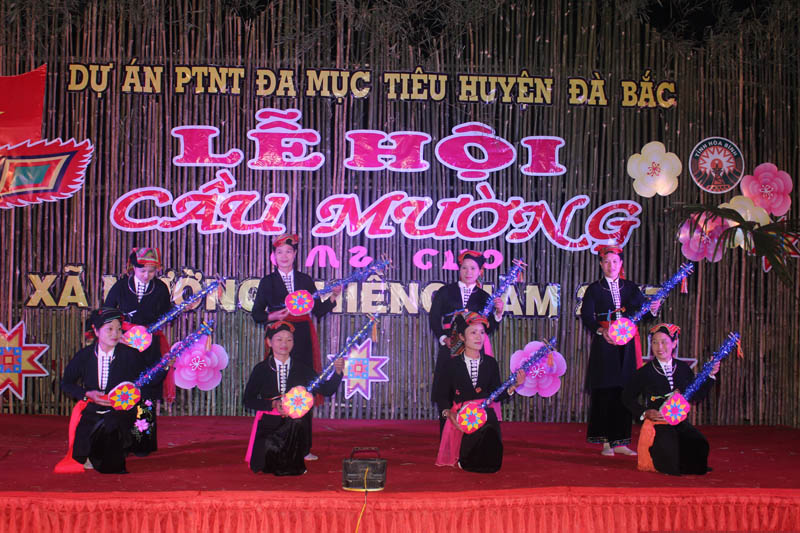
(HBO) – The mass art movement in Muong Chieng commune (Da Bac district, Hoa Binh province) has developed over the past time with the engagement of numerous people, creating an exciting atmosphere in production and improving locals’ spiritual and cultural lives. Art performances have played an important role in promoting local traditional cultural values.
Chairman of the communal People’s Committee Sa Van Hung said with over
90 percent of population being
Tay ethnic
people, the public art activities have received much attention from the local
Party committee, authorities and mass organisations. At present, in additional
to a commune’s art troupe, nine hamlets in the commune have set up art troupes.
Each has 10-15 members. Mass organisations such as youth, women and elder
people unions also established performance teams.
Art troupe
in Muong Chieng commune (Da Bac) usually perform to serve people.
To develop the public art movement, the communal
Party and People’s Committee have mobilised sources to upgrade and build
cultural houses to meet the local demand of performing arts and practicing
sports.
The commune hosts a number of exchanges,
competitions and festivals during special occasions such as Tet holiday,
attracting crowds of people. The quality of art programmes has been improved,
creating a cheerful atmosphere for local residents. The locals are encouraged
to join these activities to enrich their cultural and spiritual lives as well
as contribute to preserving cultural identities. Most of art troupes perform
voluntarily while actively involving in the dissemination of the Party’s
guidelines and the State’s policies and law.
Present at an art exchange night in Muong Chieng
commune, we felt the strong development of the public art movement here. The
event became a festival of local people with nearly 20 music, dance and
instrument performances, including folk songs and ethnic dances praising the
Party, late President Ho Chi Minh, and the nation’s heroic struggle.
At the end of the event, people held each
other’s hands to a dance to affirm their solidarity.
Sa Thi Thuong from class 11A4, Muong Chieng high
school boarding school said she felt very happy to practise songs and dances as
well as exchange with many people to preserve and develop local culture./.
With an increasingly vibrant and widespread emulation movement aimed at building cultured residential areas and cultured families, Yen Thuy District has been making steady progress toward improving both the material and spiritual well-being of its people, while fostering a civilized, prosperous, beautiful, and progressive community.
Once lacking recreational spaces and community facilities, Residential Group 2 in Quynh Lam Ward (Hoa Binh City) has recently received attention for the construction of a new, spacious, and fully equipped cultural house. The project followed the model of state support combined with public contributions in both labor and funding.
The "All people unite to build cultural life" movement, which has been effectively integrated with Kim Boi district’s socio-economic development goals, is fostering a lively spirit of emulation across local residential areas, hamlets, villages, public agencies, and enterprises. In addition, through the initiative, traditional cultural values are being preserved and promoted, while community solidarity and mutual support in poverty reduction and economic development are being strengthened.
A working delegation of the Hoa Binh provincial People’s Committee led by its Permanent Vice Chairman Nguyen Van Toan on June 11 inspected the progress of a project to build the Mo Muong Cultural Heritage Conservation Space linked to tourism services in Hop Phong commune, Cao Phong district.
Born and growing in the heroic land of Muong Dong, Dinh Thi Kieu Dung, a resident in Bo town of Kim Boi district, in her childhood was nurtured by the sweet lullabies of her grandmother and mother. These melodies deeply imprinted on her soul, becoming an inseparable part of her love for her ethnic group's culture. For over 20 years, this love for her hometown has driven Dung to research, collect, and pass down the cultural values of the Muong people to future generations.
In the final days of May, the Ethnic Art Troupe of Hoa Binh Province organized performances to serve the people in remote, mountainous, and particularly disadvantaged areas within the province. These were not just ordinary artistic shows, but they were the meaningful journeys aimed at spreading cultural values, enhancing the spiritual life of the people and contributing to the preservation of ethnic minority cultural identities.



